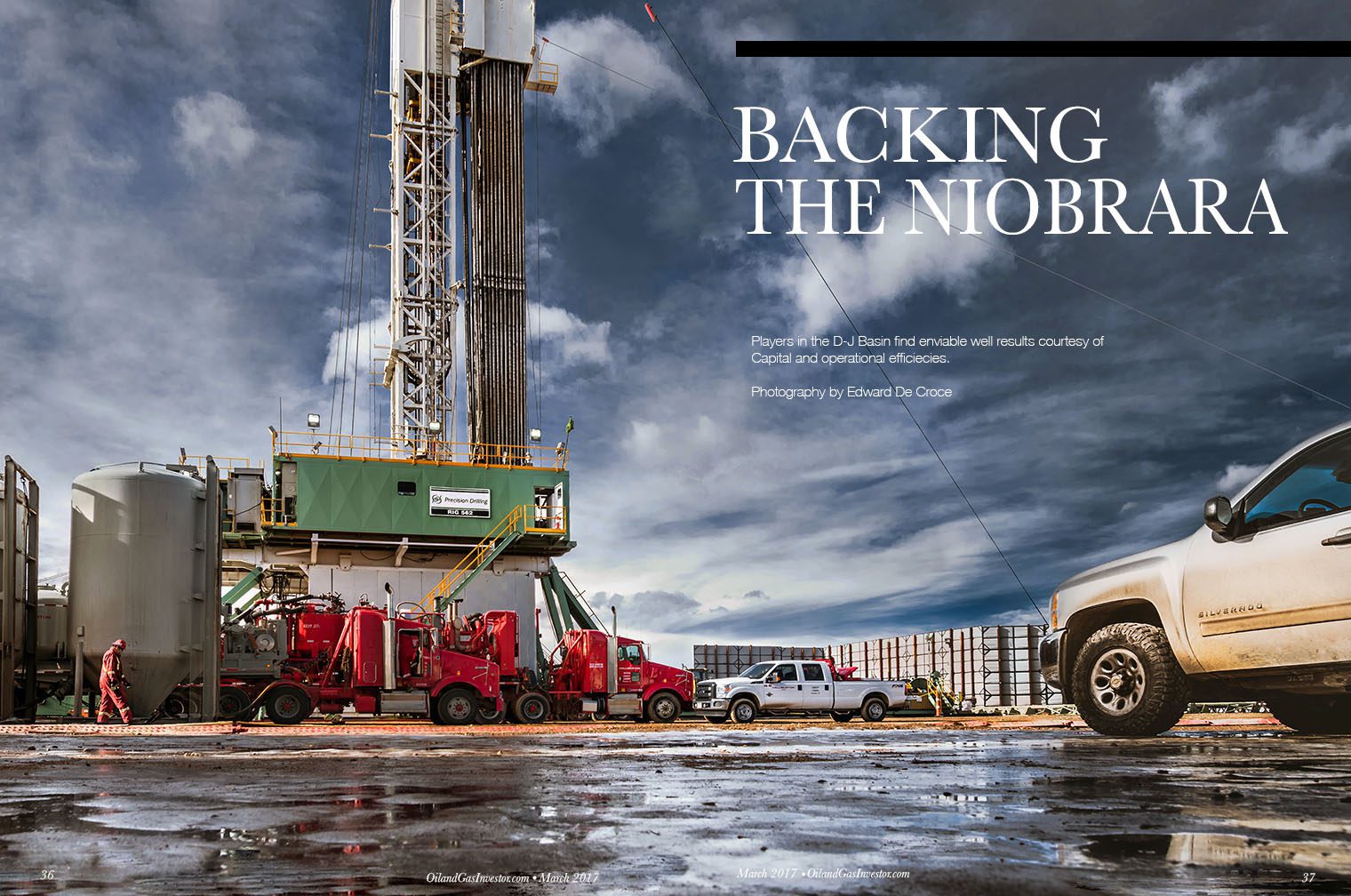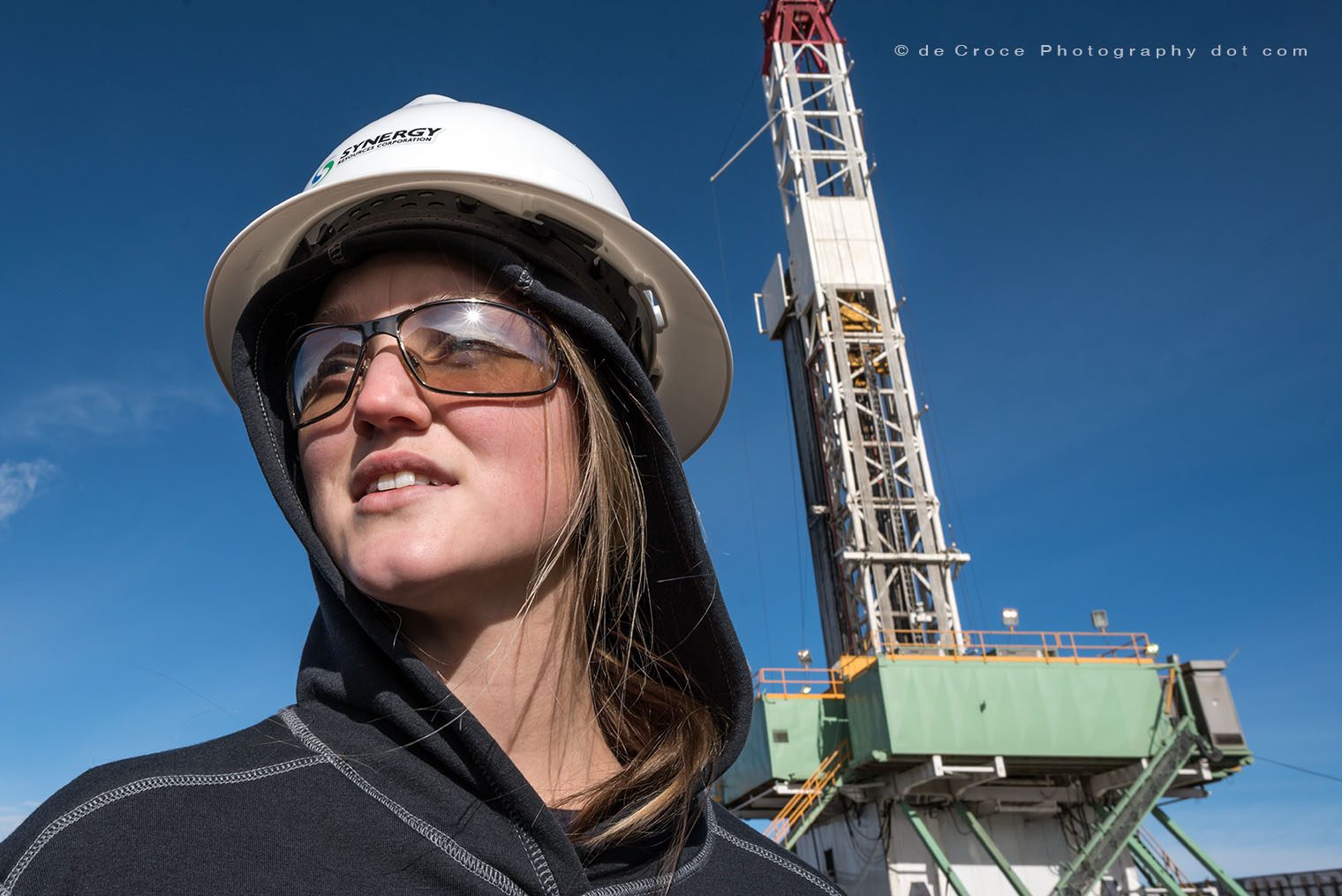Photo-shoot for Oil and Gas Investor Magazine
by Edward C. De Croce
This winter, I was commissioned by Oil and Gas Investor Magazine for a cover story on Colorado Industrial photography and Petroleum.
I’m glad the editors thought highly of my work. In the age of clever-phone-cameras, magazine photography feeds starving pro photographers.
Oh, it’s not that I’ve given up on consumer photography. In fact, my next blog post will feature fabulous family photography created during autumn’s warm-light bath. But of all the photography projects I do, Colorado industrial photography is one of the most fascinating.

A flare stack at a drilling site in the D-J basin makes for a dramatic image. During post production, I first thought the worker might be out of focus. But the heat waves from the flare is what creates the blur.

This low angle photography of an oil drilling site was a favorite with the art directors at Oil and Gas Investor Magazine. They used it as the opening two-page spread of the story. For this shot, I used the Nikon D750 and its live-view monitor. In the old days, I would have had to lie on the cold ice to get the shot. And for the duration of the photo-shoot, I would have been a lot chillier.
.
Colorado Industrial photography
and energy photography is as interesting as it is challenging. I draw from past experiences as a pro photographer. Quick visualization mixed with conceptual ideas lead to compelling images (hopefully). For projects on Colorado Industry photography, I rely on levels of skills acquired from many photography categories. Here are three:
- Photojournalism skills learned under the tutelage of Gunnison newspaper editor Joanne Williams.
- Fine art landscape photography honed while guiding whitewater river expeditions.
- Business photography Denver. The stuff I do every week.
Oil and Gas Investor Magazine is a Hart Energy publication and is published in Houston TX. The story, written by Chris Sheehan centers on lucrative investment opportunities in the Niobrara within the Denver Julesburg (D-J) basin.
The Niobrara is a North American geologic formation that was deposited between 87 and 82 million years ago. Fossil fuels can be found in Niobrara shale. Geologists look between a chalk member overlying a limestone member – at depths of 3,000 to 14,000 feet. Images in this post came from a drilling site near Platteville Colorado operated by Synergy Resourses. Now I have to say, the folks from Synergy were as hospitable and friendly as can be. Foreman Kenny gave me the freedom I needed while keeping me safe.
January’s coldest temps (minus 28°F) were just two days previous, and the brisk wind numbed my distal ends. Working with gloves could have helped, but I’m to stubborn to wear them. The cold front hung over the foothills blocking long views of white peaks, so I revisited the area the following week to capture dawn shots.
Accolades:
After the Colorado industrial photography shoot was finished I received some rave reviews from the magazine:
“I’d like to start off with saying the photography has been a hot topic of discussion around here and it has been VERY well received by many around here.”
“Wow, these are fantastic. You managed to capture everything I’m looking to illustrate in this cover article. Really great work.”
……………..Robert D. Avila – Art Director – Oil and Gas Investor

Dawn frost on winter grass offsets Platte River scene in Colorado landscape image.

Weld County in northeastern Colorado is the heart of the D-J basin with over 4000 wells.

Left image is the cover of March’s O&G Investor. While the gloves image at right would have been a great back-cover, it was used as a full page spread within the article.


The structure behind this worker is part of a “sound wall” created to disperse sound and appease neighbors of oil drilling operations.




It’s no longer unusual to see women at oil and gas drilling sites.

Colorado industrial photography meets Colorado agriculture. Although this shot was not used in the article, it was one of my favorite images. Dawn breaks on dormant irrigation system near petroleum drilling site.

In the rural plains of Colorado – melding agriculture and petroleum.
.
.
Photographers, writers and artists often look at the world differently from others. They concentrate on the minutest of details while simultaneously seeing a larger view. Their job, after all, is to record humanity’s travel trough time. And time takes on new meaning to a photographer who is well beyond fifty years old – it shrinks. Suddenly 150 years doesn’t seem like a large block of time. A century and a half of history is not actually a big leap for our minds to grasp. Looking backward in time or projecting into the future 150 years is like gazing at the stars. It gives us perspective.
I retrace my mind’s meanderings of that frigid morning when I study the last picture of this post. This is not a particularly interesting image without the following observation. What did the landscape look like in 1867 – before industry? And what will the same spot be in 2167?
At first glance, the photograph is a depiction of rural Colorado – a melding of agriculture and the petroleum industry. But what about the elements we take for granted? Dividing the composition in half are giant timbers built to carry our communication wires. How much longer will those be necessary? On the left we see that familiar two lane blacktop as it reaches over the near horizon. Of course roads have existed since the invention of the wheel. But how relevant will roads be to future human travel?
The right side of the composition is reason for my making the photograph. Derricks exist for an extremely short time – just a few months. How many years will the resulting well pump crude? And the biggest question: How much longer can humans’ rapid consumption of fossil fuel be maintained?
Climate Science, Economics and Politics
In the big view of human existence, could it be that we are living at the apex of civilization? During this 150 year span – since 1867, a planetary virus we call Homo sapiens has expanded to every edge of the globe. Humanity now possesses the means by which its very existence could be terminated. Here are three ways:
Human population growth is a runaway train. At the current rate of one billion added bodies every 12 years, Earth would be home to 20 people billion by 2167.
Nuclear Annihilation is not only possible, it’s probable. How much longer can the nuclear arsenal club of nine nations remain fixed? And the bigger question: How much longer can the nine nations control their own governments?
Climate Change is curious. While the rate of warming is fast by scientific standards, it’s slow enough to lull humans to inaction. Decades of discussion have lead to a general agreement – the planet is warming. But powerful elements of political persuasion deny human culpability.
The political divide impacting our little world-view in 2017 seems irreparable. In the USA, the political divisions are so acute that people have stopped exchanging thoughts with those who are not like minded. Take this post for example… Right wing readers won’t like it because of the section on climate change while progressive friends condemn using my talent for the O&G Colorado industrial photography project.
Opinions shaped by economics have been outdone only by opinions created by the alternative-fact driven world. Does it seem odd that the same scientific methods used to create industry are being ignored by climate deniers? Anti-science thought reigns in 2017. The current administration’s focus is clearly on bolstering a sagging industrial economy. It may indeed lead to a stronger US economy for a short term, but at what cost? Integrity, empathy and the environment, (not to mention America’s reputation) might prove difficult to restore. If we ignore science do we become ignorant?
But hypocrisy thrives on all sides of the political spectrum. I saw a “Stop Climate Change” bumper sticker on an SUV toting a trailer of high powered ski-mobiles as it raced up a mountain road in a lower gear at 85 mph. At times, educated lefties seem to be clueless about what fuels their lives of relative ease. On the other hand, factions under the category “urban elite” cannot fathom the global economic chaos caused by sudden reversal of oil consumption.
It has often been said that people are sheep. Imagining humanity as a single organism, this statement rings true. If opposing ideologies suddenly arrived at the agreement that human activity is the catapult of global warming, a step would be taken. But can enough individuals truly alter their daily habits to reverse climate change ? Without concerted cooperation between governments, industry and the ruling 1%, ordinary climate activism amounts to nothing more than a mosquito pissing in the ocean.
Ironically, an irreparable political divide might be precisely what saves humanity. The trajectory of action set in motion by the 2016 election in the USA, is designed to rip apart long trusted alliances and dismantle institutions. The very institutions that serve to stave off catastrophe are being abolished or minimized. A new order exists in the vacuum – one of unshackled industrial growth. If this course results in environmental catastrophe, as those on the left believe, it could be the silver lining of an ominous cloud. Perhaps catastrophe is the only impetus strong enough to reshape destiny. In this scenario, floods, super storms, and fires from drought lead to famine which in turn lead to war, creating a shift in human thought and subsequently. . . human evolution.
